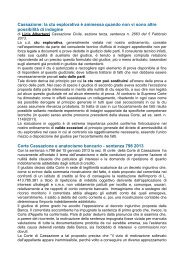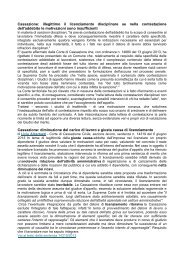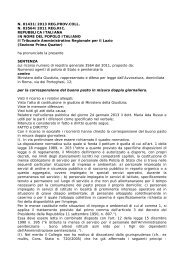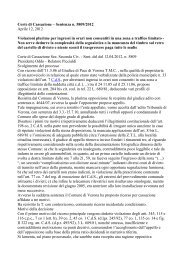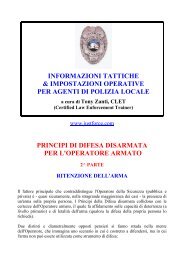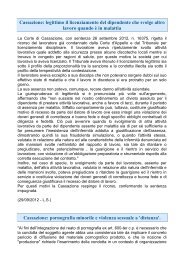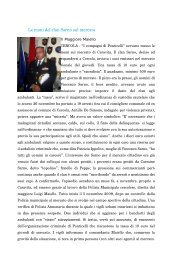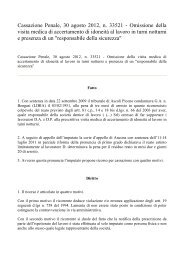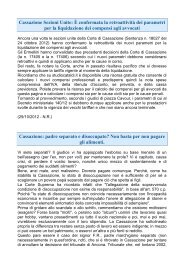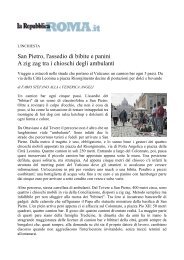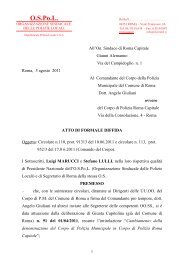consigli per la sicurezza di chi va in bicicletta - Comune di Bubbiano
consigli per la sicurezza di chi va in bicicletta - Comune di Bubbiano
consigli per la sicurezza di chi va in bicicletta - Comune di Bubbiano
You also want an ePaper? Increase the reach of your titles
YUMPU automatically turns print PDFs into web optimized ePapers that Google loves.
Mobilità, Ambiente,<br />
Arredo urbano, Verde<br />
CONSIGLI<br />
PER LA SICUREZZA<br />
DI CHI VA<br />
IN BICICLETTA
PREFAZIONE<br />
Questo opuscolo è de<strong>di</strong>cato a un “piccolo angelo” <strong>in</strong> <strong>bicicletta</strong><br />
entrato nel cuore <strong>di</strong> Mi<strong>la</strong>no e dei mi<strong>la</strong>nesi, che non <strong>di</strong>menticheremo<br />
mai: Giacomo Scalmani, il ragazz<strong>in</strong>o <strong>di</strong> 12 anni che, sabato 5<br />
novembre 2011, è stato travolto e ucciso da un tram <strong>in</strong> via<br />
So<strong>la</strong>ri, mentre sta<strong>va</strong> tornando a casa sul<strong>la</strong> sua mounta<strong>in</strong> bike dopo<br />
l’oratorio. Nel buio del<strong>la</strong> sera, sotto <strong>la</strong> pioggia, Giacomo ha tro<strong>va</strong>to<br />
improvvisamente da<strong>va</strong>nti a sé <strong>la</strong> portiera a<strong>per</strong>ta <strong>di</strong> un’auto, ed è<br />
caduto sui b<strong>in</strong>ari proprio mentre sta<strong>va</strong> passando il tram. Una vita<br />
<strong>per</strong>duta <strong>per</strong> sempre <strong>in</strong> una trage<strong>di</strong>a assurda che, forse, pote<strong>va</strong><br />
essere evitata.<br />
Giacomo era un bamb<strong>in</strong>o buono e dolce, con <strong>la</strong> timidezza e <strong>la</strong><br />
simpatia del<strong>la</strong> sua gio<strong>va</strong>ne età.<br />
Era anche molto religioso: frequenta<strong>va</strong> <strong>la</strong> parroc<strong>chi</strong>a del<strong>la</strong><br />
Madonna del Rosario, dove cent<strong>in</strong>aia <strong>di</strong> <strong>per</strong>sone - a partire dal<br />
nostro S<strong>in</strong>daco Giuliano Pisapia e da molti altri esponenti<br />
dell’Amm<strong>in</strong>istrazione comunale - si sono strette <strong>in</strong>torno al<strong>la</strong> famiglia<br />
<strong>in</strong> una veglia <strong>di</strong> <strong>la</strong>crime e <strong>di</strong> silenzio e <strong>in</strong> un ultimo, commovente, saluto.<br />
A Giacomo piace<strong>va</strong> leggere <strong>la</strong> Bibbia, ogni giorno una pag<strong>in</strong>a,<br />
tro<strong>va</strong>ndo <strong>in</strong> quelle parole così alte un significato profondo che<br />
arric<strong>chi</strong><strong>va</strong> <strong>la</strong> sua esistenza, purtroppo breve.<br />
L’immag<strong>in</strong>e <strong>di</strong> questo bamb<strong>in</strong>o, <strong>in</strong> sel<strong>la</strong> al<strong>la</strong> sua amata bici <strong>per</strong> l’ultima<br />
volta <strong>in</strong> una sera <strong>di</strong> pioggia, ci fa sentire profondamente tristi.<br />
Di fronte al<strong>la</strong> sua morte, <strong>la</strong> città - a partire da questa Amm<strong>in</strong>istrazione - ha<br />
dato una risposta <strong>di</strong> grande solidarietà e <strong>di</strong> affetto.<br />
Insieme e accanto al<strong>la</strong> vic<strong>in</strong>anza del cuore, <strong>per</strong>ò, c’è e cont<strong>in</strong>uerà<br />
a esserci anche l’impegno a mettere <strong>in</strong> pratica tutte quelle azioni<br />
necessarie a evitare che si ripetano trage<strong>di</strong>e come quel<strong>la</strong> del<br />
piccolo Giacomo Scalmani. È con questa responsabilità che il<br />
Consiglio comunale de<strong>di</strong>ca queste pag<strong>in</strong>e al<strong>la</strong> sua memoria.<br />
Ciao Giacomo, nostro piccolo angelo <strong>in</strong> <strong>bicicletta</strong>.<br />
Basilio Rizzo<br />
Presidente del Consiglio comunale <strong>di</strong> Mi<strong>la</strong>no
La trage<strong>di</strong>a <strong>di</strong> Giacomo ci ha colpito al cuore. Ci ricorda quanto<br />
Mi<strong>la</strong>no sia una città <strong>per</strong> le biciclette ma non sempre una città<br />
<strong>per</strong> i ciclisti.<br />
Mentre i mi<strong>la</strong>nesi riscoprono <strong>la</strong> <strong>bicicletta</strong> come mezzo pratico,<br />
economico e <strong>per</strong> nul<strong>la</strong> <strong>in</strong>qu<strong>in</strong>ante <strong>per</strong> muoversi, <strong>per</strong> s<strong>va</strong>go e <strong>per</strong><br />
andare al <strong>la</strong>voro non vi è stato f<strong>in</strong>’ora uno sviluppo <strong>di</strong> <strong>in</strong>terventi<br />
<strong>per</strong> muoversi <strong>in</strong> <strong>sicurezza</strong> e numerosi <strong>in</strong>cidenti co<strong>in</strong>volgono le<br />
“utenze deboli”, pedoni e ciclisti.<br />
Andare <strong>in</strong> <strong>bicicletta</strong> è una buona abitu<strong>di</strong>ne e un’alternati<strong>va</strong> all’auto<br />
o al<strong>la</strong> moto. Anche <strong>per</strong> questo il <strong>Comune</strong> <strong>di</strong> Mi<strong>la</strong>no sta <strong>la</strong>vorando<br />
a una nuo<strong>va</strong> mobilità. Pensiamo a una città <strong>di</strong>namica e moderna<br />
ma poco <strong>in</strong>qu<strong>in</strong>ata, rumorosa e caotica. Una città all’altezza dei<br />
nostri bamb<strong>in</strong>i e dei nostri bisogni. Vogliamo raddoppiare le<br />
piste cic<strong>la</strong>bili lungo strade a maggiore domanda e <strong>in</strong>tegrarle con<br />
altre modalità <strong>di</strong> trasporto. Incrementeremo le zone 30, dove <strong>la</strong><br />
velocità massima <strong>la</strong> stabilisce <strong>la</strong> <strong>bicicletta</strong>.<br />
Installeremo nuove rastrelliere e svilup<strong>per</strong>emo il bike shar<strong>in</strong>g.<br />
Per <strong>la</strong> prima volta è consentito e gratuito il trasporto delle<br />
biciclette sui mezzi pubblici f<strong>in</strong>o alle 7 del matt<strong>in</strong>o e dalle 20 a<br />
<strong>chi</strong>usura del servizio.<br />
Nessun mezzo <strong>per</strong>ò sarà mai abbastanza sicuro se noi <strong>per</strong> primi<br />
non conosciamo e rispettiamo le regole. Redatto dal <strong>Comune</strong><br />
<strong>di</strong> Reggio Emilia e da Fiab Ciclobby, questo manuale è un aiuto<br />
a gestire le situazioni <strong>di</strong> <strong>di</strong>fficoltà, conoscere bene <strong>la</strong> strada e<br />
prevedere gli errori degli automobilisti. Prima <strong>di</strong> salire <strong>in</strong> sel<strong>la</strong><br />
meglio leggerlo. Dopo, anche andare <strong>in</strong> <strong>bicicletta</strong>, sarà più sicuro.<br />
Il manuale nasce <strong>in</strong> un <strong>Comune</strong> che è punto <strong>di</strong> riferimento <strong>per</strong> <strong>la</strong><br />
cic<strong>la</strong>bilità <strong>in</strong> Italia, da oggi è a <strong>di</strong>sposizione dei mi<strong>la</strong>nesi, s<strong>per</strong>iamo<br />
che anche i ciclisti del<strong>la</strong> nostra città lo trov<strong>in</strong>o utile.<br />
Pierfrancesco Maran<br />
Assessore al<strong>la</strong> Mobilità, Ambiente, Arredo urbano e Verde<br />
<strong>Comune</strong> <strong>di</strong> Mi<strong>la</strong>no
Il Co<strong>di</strong>ce del<strong>la</strong> strada, con <strong>di</strong>sposizione purtroppo ampiamente sotto<strong>va</strong>lutata<br />
(art. 230, comma 1), prevede programmi <strong>di</strong> educazione<br />
stradale nelle scuole, anche al f<strong>in</strong>e <strong>di</strong> promuovere l’uso del<strong>la</strong> <strong>bicicletta</strong><br />
come mezzo <strong>di</strong> trasporto. In generale, <strong>in</strong>formazione, educazione<br />
e rieducazione rappresentano un tassello fondamentale <strong>per</strong> costruire<br />
una “cultura del<strong>la</strong> <strong>sicurezza</strong> stradale” e costituiscono un elemento<br />
impresc<strong>in</strong><strong>di</strong>bile <strong>per</strong> il <strong>la</strong>voro <strong>di</strong> promozione dell’uso del<strong>la</strong> bici.<br />
Non è solo questione <strong>di</strong> <strong>di</strong>stribuire torti o ragioni <strong>in</strong> caso <strong>di</strong> <strong>in</strong>cidente,<br />
ma soprattutto <strong>di</strong> prevenirli, <strong>di</strong> proteggere l’<strong>in</strong>columità fisica<br />
del ciclista, <strong>di</strong> assegnare al<strong>la</strong> bici quel<strong>la</strong> <strong>di</strong>gnità <strong>di</strong> mezzo <strong>di</strong> trasporto<br />
tante volte negata, con <strong>la</strong> prospetti<strong>va</strong> <strong>di</strong> favorire il più possibile<br />
l’utilizzo <strong>di</strong>ffuso del<strong>la</strong> <strong>bicicletta</strong>, <strong>in</strong> <strong>sicurezza</strong> (sono ancora molte le<br />
<strong>per</strong>sone che non utilizzano <strong>la</strong> bici <strong>per</strong> timore del traffico). Occorre<br />
partire dal<strong>la</strong> consapevolezza dei <strong>di</strong>ritti e dei doveri <strong>per</strong> un’affermazione<br />
responsabile del<strong>la</strong> presenza dei ciclisti sulle strade, dove essi<br />
non hanno una posizione <strong>in</strong>feriore agli altri utenti. D’altro canto,<br />
il semplice rispetto delle regole del<strong>la</strong> circo<strong>la</strong>zione non è sufficiente<br />
a garantire <strong>la</strong> <strong>sicurezza</strong> del ciclista e <strong>in</strong> qualche caso può avere<br />
ad<strong>di</strong>rittura effetti controproducenti (si pensi ai casi <strong>di</strong> a<strong>per</strong>tura improvvisa<br />
degli sportelli <strong>di</strong> auto <strong>in</strong> sosta, rispetto al ciclista che tiene<br />
correttamente <strong>la</strong> destra). E anche alcuni <strong>di</strong>spositivi <strong>di</strong> protezione <strong>in</strong><strong>di</strong>viduale<br />
(come il casco), non solo non devono sostituire misure <strong>di</strong><br />
prevenzione colletti<strong>va</strong>, ma possono rive<strong>la</strong>rsi <strong>in</strong>adeguati se il ciclista<br />
si muove come uno sprovveduto nelle <strong>in</strong>si<strong>di</strong>e del traffico.<br />
Creare attenzione è l’obiettivo del<strong>la</strong> guida che il <strong>Comune</strong> <strong>di</strong> Mi<strong>la</strong>no<br />
ha realizzato, riaprendo meritoriamente un <strong>di</strong>alogo virtuoso<br />
<strong>in</strong>terrotto ormai da troppo tempo.<br />
Prudenza. Qualità <strong>di</strong> <strong>chi</strong> <strong>va</strong>luta con ponderazione ciò che è opportuno<br />
fare e agisce <strong>in</strong> modo da evitare ris<strong>chi</strong> <strong>in</strong>utili a sé e agli altri.<br />
Essa non si confonde con <strong>la</strong> timidezza o <strong>la</strong> paura, né con <strong>la</strong> doppiezza<br />
o <strong>la</strong> <strong>di</strong>ssimu<strong>la</strong>zione. La prudenza è <strong>la</strong> capacità <strong>di</strong> <strong>di</strong>st<strong>in</strong>guere<br />
le cose da fare da quelle da evitare (Marco Tullio Cicerone).<br />
Eugenio Galli<br />
Presidente Fiab Ciclobby onlus
SUGGERIMENTI GENERALI 2<br />
INDICE<br />
Collisione N° 1<br />
4<br />
L’INCROCIO A DESTRA<br />
Collisione N° 2<br />
6<br />
LA PORTIERA APERTA<br />
Collisione N° 3<br />
7<br />
IL SEMAFORO ROSSO<br />
Collisione N° 4<br />
9<br />
IL GANCIO A DESTRA (1° tipo)<br />
Collisione N° 5<br />
10<br />
IL GANCIO A DESTRA (2° tipo)<br />
Collisione N° 6<br />
11<br />
L’INCROCIO A SINISTRA<br />
Collisione N° 7<br />
12<br />
L’IMPATTO POSTERIORE (1°tipo)<br />
Collisione N° 8<br />
13<br />
L’IMPATTO POSTERIORE (2°tipo)<br />
Collisione N° 9<br />
14<br />
IN BICI SUI PASSAGGI PEDONALI<br />
Collisione N° 10<br />
15<br />
LO SCONTRO FRONTALE CONTROMANO<br />
Collisione N° 11<br />
16<br />
LO SCONTRO NELLE ROTATORIE<br />
APPROFONDIMENTI<br />
17<br />
IL CODICE DELLA STRADA 18
SUGGERIMENTI GENERALI<br />
1) Evitare strade trafficate e possibilmente, scegliere it<strong>in</strong>erari<br />
provvisti <strong>di</strong> piste cic<strong>la</strong>bili.<br />
Uno degli errori più frequenti che le <strong>per</strong>sone commettono quando <strong>in</strong>iziano<br />
a muoversi <strong>in</strong> <strong>bicicletta</strong> è <strong>per</strong>correre esattamente le stesse strade <strong>di</strong> quando<br />
si muovono <strong>in</strong> auto.<br />
In generale è meglio scegliere strade con meno auto e dove il traffico<br />
è più lento. Stu<strong>di</strong>ando bene il <strong>per</strong>corso, si scopriranno molte strade secondarie,<br />
più tranquille, che <strong>per</strong>mettono <strong>di</strong> raggiungere ugualmente <strong>la</strong> meta,<br />
attraversando soltanto le strade pr<strong>in</strong>cipali anziché <strong>per</strong>correndole.<br />
Bisogna ricordarsi <strong>in</strong>oltre che, se ci sono piste cic<strong>la</strong>bili, i ciclisti sono<br />
OBBLIGATI ad usarle.<br />
Le cart<strong>in</strong>e dei <strong>per</strong>corsi cic<strong>la</strong>bili <strong>di</strong> Mi<strong>la</strong>no sono <strong>di</strong>sponibili presso<br />
l’assessorato Mobilità, Ambiente, Arredo urbano e Verde, <strong>in</strong><br />
Via Beccaria 19.<br />
2) Rendersi visibili. Troppo ovvio Bene, se è così, allora <strong>per</strong>ché<br />
molti ciclisti viaggiano senza fanali e catarifrangenti al<strong>la</strong> sera o <strong>di</strong><br />
notte<br />
Luci e cata<strong>di</strong>ottri non sono optional; sono <strong>in</strong>vece elementi fondamentali<br />
e anche obbligatori <strong>per</strong> <strong>la</strong> <strong>sicurezza</strong> del ciclista e devono qu<strong>in</strong><strong>di</strong> essere<br />
sempre presenti e <strong>in</strong> con<strong>di</strong>zioni <strong>di</strong> efficienza. In commercio si possono<br />
tro<strong>va</strong>re luci rosse <strong>in</strong>termittenti posteriori da usare come <strong>in</strong>tegrazione.<br />
Meglio ancora usare fanali che funzionano con <strong>la</strong> <strong>di</strong>namo, così non si<br />
scaricano le batterie e non si producono rifiuti <strong>per</strong>icolosi e <strong>di</strong>fficili da<br />
smaltire. E’ <strong>in</strong>oltre utile <strong>in</strong>dossare pettor<strong>in</strong>a rifrangente e abiti sgargianti,<br />
soprattutto <strong>di</strong> notte. Capi <strong>di</strong> colore arancione o giallo riflettenti fanno<br />
<strong>la</strong> <strong>di</strong>fferenza. Anche le fasce rifrangenti <strong>di</strong> bretelle o ferma pantaloni<br />
sono una soluzione <strong>va</strong>lida e poco costosa.<br />
2
3) Segna<strong>la</strong>re <strong>la</strong> propria presenza suonando il campanello<br />
A volte ci si sente a <strong>di</strong>sagio a suonare il campanello, ma è certo meglio<br />
pro<strong>va</strong>re imbarazzo piuttosto che essere <strong>in</strong>vestiti. Anche il campanello è obbligatorio,<br />
ma è bene o<strong>per</strong>are una scelta accurata, preferendo modelli che<br />
siano ben u<strong>di</strong>bili anche a <strong>di</strong>stanza e nel caos del traffico.<br />
4) Guardarsi alle spalle<br />
Usare uno spec<strong>chi</strong>etto retrovisore. Ce ne sono <strong>di</strong> <strong>di</strong>verso tipo, da applicare<br />
al manubrio, al caschetto o agli oc<strong>chi</strong>ali. Anche se non si tratta <strong>di</strong> un accessorio<br />
<strong>in</strong><strong>di</strong>spensabile può essere molto utile <strong>per</strong> tenere sotto controllo il<br />
traffico anche alle spalle.<br />
5) Rispettare le norme<br />
Conoscere e rispettare norme e segnaletica è un modo <strong>per</strong> partecipare consapevolmente<br />
al<strong>la</strong> propria <strong>sicurezza</strong>, con<strong>di</strong>zione necessaria anche se non sufficiente.<br />
6) Essere prudenti<br />
Prudenza e buon senso aiutano a prevenire <strong>in</strong>cidenti. Evitare se possibile le<br />
strade più trafficate; peda<strong>la</strong>re come se si fosse <strong>in</strong>visibili; <strong>va</strong>lutare i <strong>per</strong>icoli che<br />
stanno <strong>in</strong>torno.<br />
7) Cercare il contatto visivo con i conducenti degli altri veicoli<br />
Molto utile è guardare negli oc<strong>chi</strong> <strong>chi</strong> guida <strong>per</strong> rendersi conto se ci ha visto o se<br />
è <strong>di</strong>stratto. Nel caso, ri<strong>chi</strong>amare <strong>la</strong> sua attenzione è importante <strong>per</strong> tutti e due!<br />
8) Segna<strong>la</strong>re con le braccia l’<strong>in</strong>tenzione <strong>di</strong> svoltare a destra/<br />
s<strong>in</strong>istra o <strong>di</strong> spostarsi al centro del<strong>la</strong> carreggiata<br />
Per <strong>per</strong>mettere agli altri utenti del<strong>la</strong> strada <strong>di</strong> capire dove andremo <strong>in</strong> modo<br />
che possano comportarsi <strong>di</strong> conseguenza. Nel<strong>la</strong> complessità del<strong>la</strong> mobilità<br />
citta<strong>di</strong>na, il ciclista deve attenersi scrupolosamente al Co<strong>di</strong>ce del<strong>la</strong> Strada<br />
come se fosse al<strong>la</strong> guida <strong>di</strong> un’auto; prima <strong>di</strong> tutto <strong>per</strong>ché <strong>in</strong> caso <strong>di</strong> <strong>in</strong>cidente<br />
con altri mezzi <strong>di</strong> trasporto ha spesso <strong>la</strong> peggio e <strong>in</strong>oltre <strong>per</strong>ché così<br />
agevo<strong>la</strong> il congestionato traffico citta<strong>di</strong>no (non andare contromano, non<br />
passare con il semaforo rosso, scendere dal<strong>la</strong> bici negli attraversamenti pedonali,<br />
non utilizzare le corsie <strong>in</strong>terne delle rotatorie).<br />
3
COLLISIONE N° 1<br />
L’INCROCIO DA DESTRA<br />
Questa è una delle situazioni più frequenti: un automobilista che<br />
esce da una strada <strong>la</strong>terale, da un parcheggio o da un passo carraio<br />
sul<strong>la</strong> destra non sempre presta attenzione a <strong>chi</strong> sopraggiunge <strong>in</strong><br />
<strong>bicicletta</strong>.<br />
COME EVITARE QUESTA COLLISIONE<br />
1. Suonare il campanello. È importante procurarsi un campanello e USARLO<br />
ogni volta che si vede un’auto avvic<strong>in</strong>arsi (o sostare) da<strong>va</strong>nti o al<strong>la</strong> propria<br />
destra.<br />
2. Rallentare. Se il ciclista non riesce a farsi notare dal guidatore (<strong>in</strong>contrandone<br />
lo sguardo, soprattutto <strong>di</strong> notte) deve rallentare tanto da poter essere <strong>in</strong><br />
grado <strong>di</strong> fermarsi completamente, se necessario.<br />
3. Procurarsi fanali e abiti catarifrangenti. Se si peda<strong>la</strong> dopo il tramonto<br />
e <strong>in</strong> con<strong>di</strong>zioni <strong>di</strong> scarsa visibilità bisogna usare sempre un fanale anteriore,<br />
uno posteriore e dotare le ruote e i pedali <strong>di</strong> catarifrangenti. E’ previsto anche<br />
dal Co<strong>di</strong>ce del<strong>la</strong> Strada. Non faranno male anche giubbetto o bretelle con<br />
4
strisce catarifrangenti che sono obbligatorie fuori dai centri abitati <strong>di</strong> notte e<br />
<strong>in</strong> città nelle gallerie.<br />
4. Consiglio pratico. Si è soliti peda<strong>la</strong>re molto vic<strong>in</strong>o al bordo del marciapiede<br />
<strong>per</strong> evitare <strong>di</strong> essere <strong>in</strong>vestiti alle spalle (ve<strong>di</strong> l<strong>in</strong>ea “A” nel<strong>la</strong> figura).<br />
Quando <strong>per</strong>ò un automobilista sopraggiunge da una <strong>la</strong>terale destra, tende<br />
a guardare al centro del<strong>la</strong> strada, non sempre <strong>in</strong> prossimità del marciapiede.<br />
Pertanto se si peda<strong>la</strong> un po’ più a s<strong>in</strong>istra (come <strong>in</strong> “B”), è più probabile<br />
che l’autista veda, ma è bene ricordare che spostarsi troppo a s<strong>in</strong>istra è<br />
sempre <strong>per</strong>icoloso dato che non si riesce a control<strong>la</strong>re il traffico che viene<br />
da <strong>di</strong>etro. Conviene qu<strong>in</strong><strong>di</strong> sempre rallentare <strong>in</strong> queste situazioni, <strong>per</strong> potersi<br />
fermare nel caso <strong>in</strong> cui l’automobilista non ci abbia visto.<br />
Peda<strong>la</strong>re all’estrema destra rende <strong>in</strong>visibile alle auto da<strong>va</strong>nti nei<br />
punti <strong>di</strong> <strong>in</strong>tersezione, peda<strong>la</strong>re più a s<strong>in</strong>istra rende vulnerabile<br />
nei confronti delle auto provenienti alle proprie spalle.<br />
Cosa scegliere<br />
Bisogna <strong>va</strong>lutare, <strong>in</strong> base al tipo <strong>di</strong> strada e al tipo <strong>di</strong> traffico e<br />
dunque <strong>in</strong> re<strong>la</strong>zione al<strong>la</strong> situazione concreta, <strong>la</strong> soluzione che<br />
sembra più sicura: sulle strade a scorrimento veloce, con molte<br />
traverse, sarà meglio stare più a destra, mentre su strade a scorrimento<br />
lento, con molte traverse, sarà più prudente stare un<br />
po’ più sul<strong>la</strong> s<strong>in</strong>istra.<br />
5
COLLISIONE N° 2<br />
LA PORTIERA APERTA<br />
Un altro tipo <strong>di</strong> <strong>in</strong>cidente si può verificare quando un’auto parcheggiata<br />
apre improvvisamente <strong>la</strong> portiera proprio da<strong>va</strong>nti a un ciclista.<br />
Se <strong>la</strong> <strong>di</strong>stanza è ridotta e i riflessi non sono pronti, l’impatto è<br />
quasi <strong>in</strong>evitabile.<br />
COME EVITARE QUESTA COLLISIONE<br />
1. Tenere d’oc<strong>chi</strong>o le auto parcheggiate. Per quanto è possibile, osser<strong>va</strong>re<br />
gli eventuali occupanti e cercare <strong>di</strong> anticipare un‘a<strong>per</strong>tura improvvisa del<strong>la</strong><br />
portiera, magari suonando il campanello, è meglio usarlo una volta <strong>in</strong> più<br />
che una <strong>in</strong> meno!<br />
2. Consiglio pratico. In presenza <strong>di</strong> veicoli <strong>in</strong> sosta spostarsi leggermente<br />
a s<strong>in</strong>istra <strong>in</strong> modo da avere un marg<strong>in</strong>e <strong>di</strong> movimento <strong>in</strong> caso <strong>di</strong> a<strong>per</strong>tura<br />
improvvisa <strong>di</strong> una portiera, compatibilmente con il resto del traffico, <strong>in</strong> partico<strong>la</strong>re<br />
quello che sopraggiunge alle proprie spalle.<br />
6
COLLISIONE N° 3<br />
IL SEMAFORO ROSSO<br />
Quando ci si ferma a un semaforo rosso (o a uno stop) imme<strong>di</strong>atamente<br />
a destra <strong>di</strong> un’automobile nel<strong>la</strong> stessa corsia e <strong>in</strong> attesa dello<br />
stesso segnale, se l’auto deve girare a destra e il ciclista deve proseguire<br />
dritto, può presentarsi una situazione <strong>di</strong> <strong>per</strong>icolo, qualora l’automobilista<br />
non veda il ciclista. La situazione è ancora più <strong>per</strong>icolosa<br />
quando si è fermi accanto a un autobus o a un camion anche <strong>per</strong>ché i<br />
mezzi pesanti hanno molti “angoli o zone cieche” (bl<strong>in</strong>d corner), che<br />
presentano ris<strong>chi</strong> mortali, vedere nel<strong>la</strong> pag<strong>in</strong>e degli approfon<strong>di</strong>menti.<br />
COME EVITARE QUESTA COLLISIONE<br />
1. Fermarsi <strong>in</strong> un punto <strong>in</strong> cui si è ben visibili. È bene fermarsi da<strong>va</strong>nti<br />
e a destra dell’auto (ve<strong>di</strong> punto “A” nel<strong>la</strong> figura) e non <strong>di</strong> fianco, <strong>in</strong> modo<br />
da essere ben visibili e non farsi tagliare <strong>la</strong> strada, al verde è bene liberare<br />
rapidamente l’<strong>in</strong>crocio; oppure, se non ci si tro<strong>va</strong> <strong>in</strong> prossimità del semaforo<br />
ma fra due auto <strong>in</strong>colonnate, è bene fermarsi da<strong>va</strong>nti al<strong>la</strong> seconda<br />
auto <strong>per</strong> <strong>per</strong>mettere a quest’ultima <strong>di</strong> vederci <strong>chi</strong>aramente (punto “B”). In<br />
questo caso, al verde, è bene non su<strong>per</strong>are da destra il veicolo che precede<br />
<strong>per</strong>ché potrebbe svoltare improvvisamente a destra e tagliare <strong>la</strong> strada.<br />
7
2. Non confidare che tutti gli automobilisti utilizz<strong>in</strong>o sempre e <strong>in</strong><br />
modo corretto gli <strong>in</strong><strong>di</strong>catori <strong>di</strong> <strong>di</strong>rezione. Quello del<strong>la</strong> freccia (art.154,<br />
comma 1 Cds) spesso non rispettato. Soprattutto agli <strong>in</strong>croci è fondamentale<br />
essere sempre vigile e comportarsi come se l’auto <strong>di</strong> fianco possa svoltare<br />
all’improvviso senza segna<strong>la</strong>rlo.<br />
3. Attenzione nel su<strong>per</strong>are veicoli fermi <strong>in</strong> prossimità <strong>di</strong> un semaforo.<br />
La portiera destra potrebbe essere a<strong>per</strong>ta improvvisamente <strong>per</strong> <strong>la</strong> <strong>di</strong>scesa<br />
del passeggero o l’auto potrebbe <strong>in</strong>aspettatamente affiancarsi al marg<strong>in</strong>e<br />
destro del<strong>la</strong> carreggiata o entrare <strong>in</strong> un parcheggio.<br />
8
COLLISIONE N° 4<br />
IL GANCIO A DESTRA (1° TIPO)<br />
Quando un’auto su<strong>per</strong>a un ciclista <strong>in</strong> prossimità <strong>di</strong> un <strong>in</strong>crocio, potrebbe<br />
dover svoltare a destra, tagliando <strong>la</strong> strada al ciclista, una manovra<br />
che si verifica spesso nelle rotatorie da parte dei veicoli <strong>in</strong> uscita.<br />
Questo tipo <strong>di</strong> <strong>in</strong>cidente è molto <strong>di</strong>fficile da evitare <strong>per</strong>ché non ci<br />
si rende conto <strong>di</strong> cosa sta accadendo f<strong>in</strong>o all’ultimo momento.<br />
COME EVITARE QUESTA COLLISIONE<br />
1. Manovra <strong>di</strong> emergenza. Compatibilmente con il tipo <strong>di</strong> traffico sul<strong>la</strong><br />
strada, è bene che il ciclista si sposti un poco verso s<strong>in</strong>istra: <strong>in</strong> questo<br />
modo sarà più facile <strong>per</strong> le auto vederlo.<br />
2. Gettare uno sguardo <strong>di</strong>etro <strong>di</strong> sé o guardare lo spec<strong>chi</strong>etto retrovisore.<br />
Guardando <strong>di</strong>etro prima <strong>di</strong> arri<strong>va</strong>re all’<strong>in</strong>tersezione si riesce a capire se l’auto<br />
che sta sopraggiungendo ha <strong>in</strong>tenzione <strong>di</strong> su<strong>per</strong>are. In ogni caso è sempre<br />
bene rallentare, <strong>in</strong> modo da potersi fermare <strong>in</strong> caso <strong>di</strong> improvvisa svolta a<br />
destra dell’automobilista che ci ha su<strong>per</strong>ato. È molto utile montare uno spec<strong>chi</strong>etto<br />
retrovisore sul manubrio del<strong>la</strong> propria bici.<br />
3. Consiglio pratico: all’<strong>in</strong>terno delle piazze a circo<strong>la</strong>zione rotatoria, all’avvic<strong>in</strong>arsi<br />
degli assi stradali <strong>in</strong> uscita, tenere il braccio s<strong>in</strong>istro teso verso l’<strong>in</strong>terno<br />
del<strong>la</strong> rotonda <strong>per</strong> segna<strong>la</strong>re che <strong>la</strong> <strong>di</strong>rezione prosegue dentro <strong>la</strong> piazza.<br />
9
COLLISIONE N° 5<br />
IL GANCIO A DESTRA (2° TIPO)<br />
Quando un’auto o un’altra bici procedono lentamente, il ciclista può<br />
avere <strong>la</strong> tentazione <strong>di</strong> su<strong>per</strong>ar<strong>la</strong> a destra, ma può succedere che durante<br />
il sorpasso il veicolo svolti a destra <strong>in</strong> una <strong>la</strong>terale, un parcheggio, un<br />
passo carraio e <strong>va</strong>da addosso al ciclista.<br />
10<br />
COME EVITARE QUESTA COLLISIONE<br />
1. Mai su<strong>per</strong>are a destra. Questo tipo <strong>di</strong> collisione è molto facile da<br />
evitare: semplicemente non bisogna su<strong>per</strong>are alcun veicolo a destra.<br />
2. Peda<strong>la</strong>re <strong>di</strong>etro. Quando si è <strong>in</strong> corsa e il veicolo che ci precede si<br />
muove lentamente è necessario peda<strong>la</strong>rgli <strong>di</strong>etro, non al<strong>la</strong> sua destra<br />
(cioè non nel<strong>la</strong> sua “zona cieca”). È <strong>in</strong>oltre fondamentale tenere una<br />
<strong>di</strong>stanza <strong>di</strong> <strong>sicurezza</strong> dal veicolo che ci precede sufficiente a garantirci <strong>la</strong><br />
possibilità <strong>di</strong> frenare <strong>in</strong> tempo. Ricordare che si sorpassa solo a s<strong>in</strong>istra e<br />
una volta verificate le con<strong>di</strong>zioni <strong>di</strong> <strong>sicurezza</strong>! E’ anche possibile segna<strong>la</strong>re<br />
<strong>la</strong> propria manovra <strong>di</strong> sorpasso con il campanello.<br />
3. Guardarsi alle spalle prima <strong>di</strong> svoltare a destra <strong>per</strong> evitare <strong>di</strong> entrare<br />
nel<strong>la</strong> traiettoria <strong>di</strong> <strong>chi</strong>, imprudentemente, su<strong>per</strong>a da destra.
COLLISIONE N° 6<br />
L’INCROCIO A SINISTRA<br />
Un’auto proveniente dal<strong>la</strong> <strong>di</strong>rezione opposta, nel<strong>la</strong> manovra <strong>di</strong> svolta a<br />
s<strong>in</strong>istra potrebbe <strong>in</strong>vestire il ciclista qualora non notasse <strong>la</strong> sua presenza.<br />
COME EVITARE QUESTA COLLISIONE<br />
1. Rendersi visibile. In con<strong>di</strong>zioni <strong>di</strong> scarsa visibilità accendere il fanale<br />
anteriore e posteriore. Indossare abiti dai colori sgargianti e rifrangenti.<br />
2. Rallentare. Cercare il contatto visivo con il guidatore del mezzo e se<br />
non ci si riesce, rallentare <strong>in</strong> modo da essere <strong>in</strong> grado <strong>di</strong> fermarsi, se<br />
necessario.<br />
3. Non su<strong>per</strong>are a destra.<br />
11
COLLISIONE N° 7<br />
L’IMPATTO POSTERIORE (1° TIPO)<br />
Per evitare un’auto parcheggiata o un altro ostacolo sul<strong>la</strong> strada, al<br />
ciclista può succedere <strong>di</strong> sbandare leggermente a s<strong>in</strong>istra, ris<strong>chi</strong>ando<br />
così <strong>di</strong> essere urtato da un’auto che sopraggiunge alle sue spalle.<br />
12<br />
COME EVITARE QUESTA COLLISIONE<br />
1. Non spostarsi mai a s<strong>in</strong>istra senza aver control<strong>la</strong>to <strong>di</strong> poterlo fare<br />
<strong>in</strong> <strong>sicurezza</strong>.<br />
Alcuni automobilisti su<strong>per</strong>ano i ciclisti sfiorandoli appena, <strong>per</strong>tanto<br />
spostandosi anche solo <strong>di</strong> poco a s<strong>in</strong>istra ci si può mettere nel<strong>la</strong> traiettoria<br />
<strong>di</strong> un’auto. E’ sempre meglio avere l’abitu<strong>di</strong>ne a una guida<br />
rettil<strong>in</strong>ea. Piuttosto è meglio fermarsi e control<strong>la</strong>re <strong>chi</strong> sopraggiunge o<br />
verificare se c’è un passaggio alternativo.<br />
2. Usare uno spec<strong>chi</strong>etto retrovisore.
Collisione n°8<br />
COLLISIONE N° 8<br />
PATTO POSTERIORE (2° tipo)<br />
L’IMPATTO POSTERIORE (2° TIPO)<br />
sto tipo Questo <strong>di</strong> <strong>in</strong>cidente tipo <strong>di</strong> <strong>in</strong>cidente è molto è temuto molto temuto dai ciclisti, dai ciclisti, ma ma non non è molto è molto comune<br />
gni caso comune è una tranne delle che collisioni nei casi più <strong>di</strong> guida <strong>di</strong>fficili notturna da evitare, o su strade poiché a lunga generalmente<br />
<strong>per</strong>correnza<br />
peda<strong>la</strong> non fuori si città. guarda In ogni <strong>di</strong>etro. caso è una delle collisioni più <strong>di</strong>fficili da<br />
ndo si<br />
evitare, poiché generalmente quando si peda<strong>la</strong> non si guarda <strong>di</strong>etro.<br />
COME EVITARE QUESTA COLLISIONE<br />
me evitare questa collisione:<br />
1. Peda<strong>la</strong>re su piste cic<strong>la</strong>bili.<br />
Peda<strong>la</strong>re su piste cic<strong>la</strong>bili.<br />
2. Rendersi visibili. Se si peda<strong>la</strong> al buio, bisogna assolutamente dotare <strong>la</strong> <strong>bicicletta</strong><br />
<strong>di</strong> un fanale rosso posteriore. posteriore, <strong>di</strong> Se catarifrangenti si peda<strong>la</strong> ai al pedali buio, e possibilmente bisogna assoluta<br />
Procurarsi<br />
ment vestire dotare le fasce <strong>la</strong> <strong>bicicletta</strong> rifrangenti re<strong>per</strong>ibili <strong>di</strong> un fanale anche nei rosso negozi posteriore, che vendono <strong>di</strong> articoli catarifrangent<br />
<strong>per</strong> <strong>la</strong><br />
<strong>sicurezza</strong> sul <strong>la</strong>voro.<br />
ai pedali e possibilmente vestire le fasce rifrangenti (che si possono tro<strong>va</strong><br />
re nei 3. negozi Quando che è possibile vendono scegliere articoli strade <strong>per</strong> <strong>la</strong> ampie. <strong>sicurezza</strong> Per gli spostamenti, sul <strong>la</strong>voro). cercare<br />
<strong>di</strong> scegliere strade provviste <strong>di</strong> una corsia esterna sufficientemente ampia da garantire<br />
è possibile una <strong>di</strong>stanza scegliere <strong>di</strong> <strong>sicurezza</strong> dalle strade auto. ampie. Per gli spostamenti, cercare<br />
Quando<br />
<strong>di</strong> scegliere strade provviste <strong>di</strong> una corsia esterna sufficientemente ampia<br />
da garantire 4. Quando una è <strong>di</strong>stanza possibile scegliere <strong>di</strong> <strong>sicurezza</strong> strade dalle con auto. traffico lento. Più il traffico<br />
è a scorrimento lento, più gli automobilisti hanno il tempo <strong>di</strong> vedere i ciclisti. Per<br />
questo è preferibile usare strade secondarie o residenziali.<br />
Quando è possibile scegliere strade con traffico lento. Più il traffico è a<br />
scorrimento lento, più gli automobilisti hanno il tempo <strong>di</strong> vedere i ciclisti 13<br />
Per questo è preferibile usare strade secondarie o residenziali.
Collisione n°9<br />
COLLISIONE N° 9<br />
IN BICI SUI PASSAGGI PEDONALI<br />
IN BICI SUI PASSAGGI PEDONALI<br />
Gli automobilisti non si aspettano <strong>di</strong> tro<strong>va</strong>re biciclette sugli attraversament<br />
riser<strong>va</strong>ti Gli ai automobilisti pedoni, <strong>per</strong>tanto, non si aspettano quando si attraversano <strong>di</strong> tro<strong>va</strong>re biciclette strisce sugli pedonali attraversamenti<br />
prestare riser<strong>va</strong>ti attenzione ai pedoni, alle <strong>per</strong>tanto, auto che quando svoltano. si attraversano le<br />
fra du<br />
marciapie<strong>di</strong><br />
strisce pedonali fra due marciapie<strong>di</strong> prestare attenzione alle auto<br />
che svoltano.<br />
COME EVITARE QUESTA COLLISIONE<br />
Come evitare questa collisione:<br />
1. Ricordarsi che <strong>la</strong> bici è un veicolo. È bene rimanere sul<strong>la</strong> strada, usando<br />
1. Ricordarsi le normali regole che <strong>la</strong> del<strong>la</strong> bici circo<strong>la</strong>zione è un veicolo. veico<strong>la</strong>re. È bene Se si rimanere preferisce sul<strong>la</strong> usare strada, comunque<br />
normali l’attraversamento regole del<strong>la</strong> pedonale circo<strong>la</strong>zione (magari veico<strong>la</strong>re. <strong>per</strong> attraversare una strada partico-<br />
usand<br />
le<br />
Se <strong>la</strong>rmente si preferisce trafficata), usare bisogna comunque scendere l’attraversamento dal<strong>la</strong> <strong>bicicletta</strong> e condur<strong>la</strong> pedonale a mano. (magari I pe<br />
attraversare ciclisti possono una rimanere strada <strong>in</strong> sel<strong>la</strong> partico<strong>la</strong>rmente al<strong>la</strong> propria bici quando trafficata), ci sono bisogna gli attraversamenti<br />
scender<br />
dal<strong>la</strong> <strong>bicicletta</strong><br />
cic<strong>la</strong>bili, cioè<br />
e condur<strong>la</strong><br />
i cosiddetti<br />
a<br />
“quadrotti”<br />
mano.<br />
<strong>di</strong> 50 x 50 cm.<br />
I ciclisti possono rimanere <strong>in</strong> sel<strong>la</strong> al<strong>la</strong> propria bici quando ci sono gli at<br />
2. Non peda<strong>la</strong>re sui marciapie<strong>di</strong> non a<strong>di</strong>biti anche a pista cic<strong>la</strong>bile.<br />
traversamenti cic<strong>la</strong>bili, cioè i cosiddetti “quadrotti” <strong>di</strong> 50x50cm.<br />
Anche se possono sembrare più sicuri rispetto al<strong>la</strong> strada, non si deve salire<br />
sui marciapie<strong>di</strong> con <strong>la</strong> bici: <strong>la</strong> presenza <strong>di</strong> pedoni, passi carrai e attraversamenti<br />
2. Non può peda<strong>la</strong>re creare situazioni sui marciapie<strong>di</strong> ris<strong>chi</strong>o. non a<strong>di</strong>biti anche a pista cic<strong>la</strong>bile. Anch<br />
se possono sembrare più sicuri rispetto al<strong>la</strong> strada, non si deve salire su<br />
marciapie<strong>di</strong> con <strong>la</strong> bici: <strong>la</strong> presenza <strong>di</strong> pedoni, passi carrai e attraversa<br />
menti può creare situazioni <strong>di</strong> ris<strong>chi</strong>o.<br />
14
COLLISIONE N° 10<br />
Collisione n°10<br />
LO SCONTRO FRONTALE CONTROMANO<br />
LO SCONTRO FRONTALE CONTROMANO<br />
Peda<strong>la</strong>ndo contromano sul <strong>la</strong>to s<strong>in</strong>istro del<strong>la</strong> strada si corrono molti<br />
ris<strong>chi</strong>: Peda<strong>la</strong>ndo un’automobilista contromano sul che <strong>la</strong>to svolta s<strong>in</strong>istro a del<strong>la</strong> destra strada una si corrono strada molti <strong>la</strong>terale, ris<strong>chi</strong>: da<br />
un un’automobilista passo carraio che o da svolta un parcheggio a destra da una control<strong>la</strong> strada <strong>la</strong>terale, <strong>di</strong> solito da un solo passo il carraio<br />
proveniente o da un parcheggio dal<strong>la</strong> sua control<strong>la</strong> s<strong>in</strong>istra <strong>di</strong> solito e può solo non il traffico vedere proveniente <strong>chi</strong> proviene dal<strong>la</strong> sua da<br />
traffico<br />
destra.<br />
s<strong>in</strong>istra<br />
Inoltre<br />
e può non<br />
<strong>chi</strong><br />
vedere<br />
<strong>per</strong>corre<br />
<strong>chi</strong> proviene<br />
<strong>la</strong> strada destra.<br />
nel<strong>la</strong> <strong>di</strong>rezione consentita, non<br />
Inoltre <strong>chi</strong> <strong>per</strong>corre <strong>la</strong> strada nel<strong>la</strong> <strong>di</strong>rezione consentita non si aspetta <strong>di</strong> vedere<br />
marciare <strong>di</strong> vedere <strong>in</strong> senso marciare contrario <strong>in</strong> una senso bici e potrebbe contrario avere una tempi bici <strong>di</strong> e reazione potrebbe<br />
si aspetta<br />
avere più lenti. tempi <strong>di</strong> reazione più lenti. Inoltre <strong>in</strong> questo caso l’urto è anche<br />
più violento <strong>per</strong>ché le velocità si sommano.<br />
COME Come EVITARE evitare questa QUESTA collisione: COLLISIONE<br />
1. Guidare 1. nel<strong>la</strong> stessa <strong>di</strong>rezione del traffico, del traffico, cioè, NON cioè, peda<strong>la</strong>re non contro-<br />
peda<strong>la</strong>re<br />
contromano. Peda<strong>la</strong>re Peda<strong>la</strong>re contromano contromano potrebbe potrebbe sembrare sembrare una buona una idea buona <strong>per</strong>ché si idea<br />
riescono a vedere le auto che sorpassano, ma non lo è. Ecco <strong>per</strong>ché:<br />
<strong>per</strong>ché si riescono a vedere le auto che sorpassano, ma non lo è.<br />
• peda<strong>la</strong>re • peda<strong>la</strong>re contro contro mano mano è espressamente è vietato dal Co<strong>di</strong>ce del<strong>la</strong><br />
Strada e si può essere multati <strong>per</strong> questo;<br />
Strada e si può essere multati <strong>per</strong> questo;<br />
• le auto che seguono <strong>la</strong> <strong>di</strong>rezione <strong>di</strong> marcia o che si immettono nel traffico<br />
che da seguono strade <strong>la</strong>terali <strong>di</strong>rezione o parcheggi <strong>di</strong> marcia e attraversano o che si immettono <strong>la</strong> strada (<strong>di</strong> nel fronte traffico<br />
• le auto<br />
a ed al<strong>la</strong> tua s<strong>in</strong>istra) non si aspettano traffico proveniente dal<strong>la</strong><br />
da strade <strong>la</strong>terali o parcheggi e attraversano <strong>la</strong> strada (<strong>di</strong> fronte e a s<strong>in</strong>istra)<br />
<strong>di</strong>rezione sbagliata;<br />
non si aspettano traffico proveniente dal<strong>la</strong> <strong>di</strong>rezione sbagliata;<br />
• le auto si avvic<strong>in</strong>eranno a una velocità più ele<strong>va</strong>ta. Se un ciclista procede<br />
a 15 km all’ora, un’auto che sorpassa da <strong>di</strong>etro a 50 km/h, si avvic<strong>in</strong>a al<strong>la</strong><br />
velocità <strong>di</strong> 35 km/h (50-15), ma se si procede nel senso opposto le<br />
velocità 14 si sommano (50+15). Poiché l’auto si avvic<strong>in</strong>a ad una velocità<br />
su<strong>per</strong>iore, sia ciclista che automobilista avranno qu<strong>in</strong><strong>di</strong> molto meno tempo<br />
<strong>per</strong> reagire, e <strong>in</strong> caso <strong>di</strong> collisione, le conseguenze saranno peggiori.<br />
15
COLLISIONE N° 11<br />
LO SCONTRO NELLE ROTATORIE<br />
Il <strong>per</strong>icolo nasce quando all’<strong>in</strong>terno <strong>di</strong> una rotatoria auto e bici<br />
non devono prendere <strong>la</strong> stessa uscita: se <strong>la</strong> bici deve cont<strong>in</strong>uare a<br />
<strong>per</strong>correre <strong>la</strong> rotonda e l’auto deve <strong>in</strong>vece uscire, il ciclista corre il<br />
ris<strong>chi</strong>o <strong>di</strong> vedersi tagliare <strong>la</strong> strada.<br />
COME EVITARE QUESTA COLLISIONE<br />
1. Usare gli attraversamenti cic<strong>la</strong>bili (dove esistenti). Sugli attraversamenti<br />
cic<strong>la</strong>bili e ciclopedonali “quadrotti” i ciclisti hanno <strong>la</strong> precedenza.<br />
Bisogna comunque fare molta attenzione, dato che non tutti rispettano<br />
quest’obbligo.<br />
2. Lasciare passare l’auto sul<strong>la</strong> propria s<strong>in</strong>istra, control<strong>la</strong>re il traffico<br />
che si ha alle spalle e spostarsi leggermente a s<strong>in</strong>istra <strong>in</strong> modo da impe<strong>di</strong>re<br />
all’auto che si ha <strong>di</strong>etro <strong>di</strong> sorpassare.<br />
3. Immettersi nel<strong>la</strong> rotonda segna<strong>la</strong>ndo <strong>chi</strong>aramente con il braccio <strong>la</strong><br />
<strong>di</strong>rezione che si vuol prendere, spostarsi sul<strong>la</strong> destra <strong>per</strong> rendersi visibili.<br />
16
APPROFONDIMENTI<br />
L’angolo cieco, una trappo<strong>la</strong> da evitare<br />
L’angolo cieco (o angolo morto, detto anche bl<strong>in</strong>d corner) è uno spazio<br />
situato attorno a un veicolo, che non risulta visibile dal posto <strong>di</strong><br />
guida. Esistono molti punti cie<strong>chi</strong>: da<strong>va</strong>nti, sui fian<strong>chi</strong>, <strong>di</strong>etro e sopra<br />
il veicolo. In questi spazi <strong>di</strong> non visibilità il conducente non può vedere<br />
gli altri utenti del<strong>la</strong> strada e ciò ha come effetto <strong>di</strong> aumentare<br />
considerevolmente il ris<strong>chi</strong>o <strong>di</strong> <strong>in</strong>cidente.<br />
Prevedere gli “angoli cie<strong>chi</strong>” è un primo passo <strong>per</strong> evitare <strong>in</strong>cidenti,<br />
anche mortali.<br />
Le 5 regole fondamentali<br />
1. Mantieni il contatto visivo: se puoi vedere gli oc<strong>chi</strong> del conducente nel<br />
suo retrovisore, anche lui può vedere te.<br />
2. Non sostare mai sotto i retrovisori del veicolo pesante o <strong>in</strong> loro corrispondenza.<br />
3. Non oltrepassare mai un veicolo pesante a destra.<br />
4. Non cercare <strong>di</strong> su<strong>per</strong>are un camion <strong>in</strong> manovra, né da destra né da s<strong>in</strong>istra,<br />
specialmente <strong>in</strong> prossimità <strong>di</strong> un <strong>in</strong>crocio.<br />
5. Ren<strong>di</strong>ti ben visibile al<strong>la</strong> sera e quando fa scuro: luce bianca da<strong>va</strong>nti,<br />
rossa <strong>di</strong>etro e <strong>di</strong>spositivi catarifrangenti.<br />
17
IL CODICE DELLA STRADA<br />
Le <strong>di</strong>sposizioni del Co<strong>di</strong>ce del<strong>la</strong> strada re<strong>la</strong>tive al veicolo <strong>bicicletta</strong>, al comportamento<br />
sulle strada e al<strong>la</strong> circo<strong>la</strong>zione.<br />
Comportamenti<br />
• posizione (art. 143CdS)<br />
• velocità (art. 141 CdS)<br />
• precedenza (art. 145 CdS)<br />
• cambiamento <strong>di</strong> <strong>di</strong>rezione (art. 154 CdS)<br />
• verso i pedoni (art. 191 CdS)<br />
• guida sotto l’<strong>in</strong>fluenza dell’alcool (art. 186 CdS)<br />
• guida <strong>in</strong> stato <strong>di</strong> alterazione <strong>per</strong> uso <strong>di</strong> sostanze stupefacenti (art. 187 CdS)<br />
Circo<strong>la</strong>zione sulle strade (art. 182 Cds)<br />
• affiancamento<br />
• conduzione a mano<br />
• giubbotti/bretelle r<strong>in</strong>frangenti (art. 182 CdS)<br />
Veicolo (requisiti <strong>bicicletta</strong>: art. 68 CdS)<br />
• luci<br />
• campanello<br />
• freni<br />
4<br />
3<br />
7 7<br />
1 2<br />
5<br />
6<br />
8 8<br />
7 7<br />
18
Massimo <strong>in</strong>gombro: <strong>la</strong>rghezza: 1,30 m - lunghezza: 3 m - Altezza: 2,20 m<br />
1e2: Due freni <strong>in</strong><strong>di</strong>pendenti, uno <strong>per</strong> ogni asse, agenti sulle ruote, con comando<br />
a mano o pedale<br />
3: Campanello <strong>per</strong> segna<strong>la</strong>zione acustica (il suono deve poter esser <strong>per</strong>cepito a 30 m)<br />
4: Luce anteriore, bianca o gial<strong>la</strong>, con altezza da terra tra 30 e 100 cm. L’asse<br />
ottico deve <strong>in</strong>contrare terra a non più <strong>di</strong> 20 m<br />
5: Luce rossa posteriore, a non più <strong>di</strong> 100 cm da terra<br />
6: Cata<strong>di</strong>ottro posteriore a luce riflessa rossa, a non più <strong>di</strong> 90 cm da terra<br />
7: Dispositivi cata<strong>di</strong>ottrici a luce riflessa gial<strong>la</strong>, sui due fianchetti <strong>di</strong> ogni pedale<br />
8: Dispositivi cata<strong>di</strong>ottrici <strong>la</strong>terali a luce riflessa gial<strong>la</strong>, sui due <strong>la</strong>ti <strong>di</strong> ogni ruota<br />
Note:<br />
a) i <strong>di</strong>spositivi ottici <strong>di</strong> segna<strong>la</strong>zione (luce anteriore e posteriore) devono essere<br />
presenti sul veicolo e essere accesi da mezz’ora dopo il tramonto a mezz’ora prima<br />
del sorgere del sole. Inoltre devono essere presenti e accesi anche nei centri abitati:<br />
nelle gallerie, con pioggia, nebbia, neve o scarsa visibilità;<br />
b) l’art. 224 del DPR 16/12/92 nr. 495, specifica le caratteristiche tecniche cui<br />
devono sod<strong>di</strong>sfare i <strong>di</strong>spositivi <strong>di</strong> segna<strong>la</strong>zione ottica;<br />
c) sono consentiti i rimor<strong>chi</strong> <strong>per</strong> velocipe<strong>di</strong> purché <strong>la</strong> lunghezza del velocipede,<br />
compreso il rimor<strong>chi</strong>o, non su<strong>per</strong>i 3 m <strong>di</strong> lunghezza. La <strong>la</strong>rghezza massima<br />
totale del rimor<strong>chi</strong>o non deve essere su<strong>per</strong>iore a 75 cm e l’altezza massima,<br />
compreso il carico, non deve essere su<strong>per</strong>iore a 1 m. La massa trasportabile non<br />
deve essere su<strong>per</strong>iore a 50 kg. Per <strong>la</strong> circo<strong>la</strong>zione notturna il rimor<strong>chi</strong>o deve essere<br />
equipaggiato con i <strong>di</strong>spositivi <strong>di</strong> segna<strong>la</strong>zione visi<strong>va</strong> posteriore (luce rossa)<br />
e <strong>la</strong>terale (cata<strong>di</strong>ottri);<br />
d) sono considerati velocipe<strong>di</strong> anche le biciclette a peda<strong>la</strong>ta assistita, dotate <strong>di</strong><br />
motore ausiliario elettrico con potenza massima <strong>di</strong> 0,25 kw <strong>la</strong> cui alimentazione<br />
viene <strong>in</strong>terrotta quando il veicolo raggiunge i 25 km/h o prima se il ciclista smette<br />
<strong>di</strong> peda<strong>la</strong>re. Se questi parametri vengono su<strong>per</strong>ati il veicolo è da considerarsi ciclomotore<br />
e <strong>per</strong>tanto <strong>per</strong> poter circo<strong>la</strong>re <strong>in</strong> pubblica via necessita <strong>di</strong> immatrico<strong>la</strong>zione,<br />
targa, certificato <strong>di</strong> circo<strong>la</strong>zione e co<strong>per</strong>tura assicurati<strong>va</strong> r.c.<br />
19
LE SANZIONI<br />
Sanzioni amm<strong>in</strong>istrative pecuniarie - Elenco delle più comuni vio<strong>la</strong>zioni del<br />
Co<strong>di</strong>ce del<strong>la</strong> strada commesse dai ciclisti e conseguente ammontare delle<br />
sanzioni (Tariffe <strong>in</strong> vigore al 01.02.2012).<br />
Inadeguatezza del mezzo<br />
Importo<br />
sanzione (€ )*<br />
Importo Rif. art.<br />
massimo(€ ) Cds<br />
Circo<strong>la</strong>re con <strong>la</strong> <strong>bicicletta</strong> pri<strong>va</strong> <strong>di</strong> impianto<br />
<strong>di</strong> illum<strong>in</strong>azione [negli orari e nei casi previsti<br />
dal CdS – vedasi punto a) delle note]<br />
24,00<br />
94,00<br />
68<br />
Circo<strong>la</strong>re con <strong>la</strong> <strong>bicicletta</strong> senza pneumatici<br />
24,00<br />
94,00<br />
68<br />
Circo<strong>la</strong>re con <strong>la</strong> <strong>bicicletta</strong> pri<strong>va</strong> dei catarifrangenti<br />
previsti<br />
24,00<br />
94,00<br />
68<br />
Circo<strong>la</strong>re con <strong>la</strong> <strong>bicicletta</strong> pri<strong>va</strong> <strong>di</strong> avvisatore<br />
acustico<br />
24,00<br />
94,00<br />
68<br />
Circo<strong>la</strong>re con <strong>la</strong> <strong>bicicletta</strong> i cui freni non<br />
esercitano una sufficiente azione frenante<br />
24,00<br />
94,00<br />
68<br />
*Pagamento <strong>in</strong> misura ridotta (entro 60 giorni)<br />
Mancato rispetto delle norme <strong>di</strong><br />
circo<strong>la</strong>zione<br />
Importo<br />
sanzione (€ )*<br />
Importo Rif. art.<br />
massimo(€ ) Cds<br />
Non avere rispettato <strong>la</strong> <strong>di</strong>stanza <strong>di</strong> <strong>sicurezza</strong><br />
39,00<br />
159,00<br />
149<br />
Farsi tra<strong>in</strong>are da un altro veicolo<br />
24,00<br />
94,00<br />
182<br />
Tra<strong>in</strong>are un altro veicolo [tranne nell’ipotesi<br />
prevista dal punto c) delle note]<br />
24,00<br />
94,00<br />
182<br />
Condurre animali<br />
24,00<br />
94,00<br />
182<br />
Percorrere <strong>in</strong> <strong>bicicletta</strong> strade vietate<br />
all’accesso dei cicli [autostrade e strade extraurbane<br />
pr<strong>in</strong>cipali]<br />
20<br />
39,00<br />
159,00<br />
175
Percorrere <strong>in</strong> <strong>bicicletta</strong> strade vietate<br />
all’accesso dei cicli [strade extraurbane secondarie]<br />
80,00<br />
318,00<br />
6<br />
Percorrere <strong>in</strong> <strong>bicicletta</strong> strade vietate<br />
all’accesso dei cicli [strade urbane]<br />
39,00<br />
159,00<br />
7<br />
Non avere acceso i fari nelle circostanze<br />
previste<br />
39,00<br />
159,00<br />
152<br />
Non aver segna<strong>la</strong>to <strong>la</strong> svolta con il braccio<br />
39,00<br />
159,00<br />
154<br />
Peda<strong>la</strong>re senza appoggiare le mani sul<br />
manubrio<br />
24,00<br />
94,00<br />
182<br />
Non avere dato <strong>la</strong> precedenza ai pedoni<br />
che si acc<strong>in</strong>gono o che hanno già com<strong>in</strong>ciato<br />
l’attraversamento del<strong>la</strong> strada<br />
154,00<br />
613,00<br />
191<br />
Procedere affiancati <strong>in</strong> numero su<strong>per</strong>iore<br />
a due o <strong>in</strong> gruppo nei centri abitati [fuori<br />
dai centri abitati procedere su unica fi<strong>la</strong>, salvo<br />
che un ciclista sia m<strong>in</strong>ore <strong>di</strong> 10 anni e proceda<br />
sul<strong>la</strong> destra dell’altro]<br />
24,00<br />
94,00<br />
182<br />
Procedere a velocità ele<strong>va</strong>ta rispetto alle<br />
circostanze<br />
39,00<br />
159,00<br />
141<br />
Procedere a zigzag tra le auto <strong>in</strong>colonnate<br />
24,00<br />
94,00<br />
182<br />
Peda<strong>la</strong>re con cuffie sonore<br />
152,00<br />
608,00<br />
173<br />
Peda<strong>la</strong>re conversando al telefon<strong>in</strong>o<br />
152,00<br />
608,00<br />
173<br />
Trasportare un passeggero adulto<br />
24,00<br />
94,00<br />
182<br />
Trasportare un bamb<strong>in</strong>o non correttamente<br />
assicurato<br />
24,00<br />
94,00<br />
182<br />
Sorpassare sul<strong>la</strong> destra<br />
76,00<br />
306,00<br />
148<br />
21
Procedere al centro del<strong>la</strong> carreggiata anziché<br />
mantenersi sul marg<strong>in</strong>e destro<br />
39,00<br />
159,00<br />
143<br />
Circo<strong>la</strong>re sul<strong>la</strong> sede stradale <strong>in</strong> luogo del<strong>la</strong><br />
pista cic<strong>la</strong>bile paralle<strong>la</strong><br />
24,00<br />
94,00<br />
182<br />
Circo<strong>la</strong>re sui marciapie<strong>di</strong> e <strong>in</strong> aree riser<strong>va</strong>te<br />
ai pedoni<br />
39,00<br />
159,00<br />
143<br />
Stare nel<strong>la</strong> scia <strong>di</strong> un veicolo a motore (velocità<br />
<strong>per</strong>icolosa)<br />
39,00<br />
159,00<br />
141<br />
Tagliare le curve <strong>in</strong><strong>va</strong>dendo <strong>la</strong> corsia opposta<br />
302,00<br />
1.207,00<br />
143<br />
Non avere ridotto <strong>la</strong> velocità e non avere<br />
rispettato le norme <strong>di</strong> prudenza <strong>in</strong> prossimità<br />
<strong>di</strong> attraversamenti pedonali e aree a<br />
circo<strong>la</strong>zione promiscua con pedoni<br />
39,00<br />
159,00<br />
141<br />
Non <strong>in</strong>dossare giubbotto o bretelle rifrangenti<br />
fuori dai centri abitati da ½ ora dopo<br />
il tramonto a ½ ora prima del sorgere del<br />
sole e <strong>di</strong> giorno nelle gallerie anche nei<br />
centri abitati<br />
23,00<br />
92,00<br />
182<br />
Altre <strong>in</strong>frazioni<br />
Importo<br />
sanzione (€ )*<br />
Importo Rif. art.<br />
massimo(€ ) Cds<br />
Non avere osser<strong>va</strong>to un or<strong>di</strong>ne <strong>di</strong> arresto<br />
da parte delle forze <strong>di</strong> polizia [segnali manuali<br />
degli agenti del traffico]<br />
154,00<br />
613,00<br />
146<br />
Non avere rispettato le <strong>in</strong><strong>di</strong>cazioni fornite<br />
dalle forze <strong>di</strong> polizia [segnali manuali degli<br />
agenti del traffico]<br />
39,00<br />
159,00<br />
146<br />
Guidare <strong>in</strong> stato <strong>di</strong> ebbrezza<br />
186<br />
Conducente > 21 anni alcolemia > 0,5 = 0,8<br />
500,00<br />
2.000,00<br />
22
Se si provoca <strong>in</strong>cidente - alcoolemia > 0,8<br />
= 1,5 (arresto f<strong>in</strong>o a 6 mesi e ammenda da<br />
800,00 a 3200,00 - pene raddoppiate se<br />
si provoca <strong>in</strong>cidente e aumentate da 1/3 a<br />
1/2 se il reato è commesso dalle ore 22:00<br />
alle ore 07:00)<br />
Alcoolemia > 1,5 (arresto da 6 mesi ad 1<br />
anno e ammenda da 1500,00 a 6000,00<br />
- pene raddoppiate se si provoca <strong>in</strong>cidente<br />
e aumentate da 1/3 a 1/2 se il reato è<br />
commesso dalle ore 22:00 alle ore 07:00)<br />
1.000,00<br />
4.000,00<br />
Guidare <strong>in</strong> stato <strong>di</strong> ebbrezza<br />
186 bis<br />
Conducente < 21 anni - alcoolemia > 0,0<br />
= 0,5<br />
se si provoca <strong>in</strong>cidente<br />
alcoolemia > 0,5 = 0,8<br />
se si provoca <strong>in</strong>cidente - alcoolemia > 0,8 =<br />
1,5 (pene <strong>di</strong> cui all’art. 186 aumentata da<br />
1/3 a 1/2 ). Alcoolemia > 1,5 (pene <strong>di</strong> cui<br />
all’art. 186 aumentata da 1/3 a 1/2 )<br />
155,00<br />
310,00<br />
666,67<br />
1.333,34<br />
624,00<br />
1.248,00<br />
2.666,67<br />
5.333,34<br />
Guidare sotto l’effetto <strong>di</strong> stupefacenti<br />
187<br />
Conducente > 21 anni (arresto da 6 mesi<br />
ad 1 anno e ammenda da 1.500,00 a<br />
6.000,00 - pene raddoppiate se si provoca<br />
<strong>in</strong>cidente e ulteriormente aumentate<br />
da 1/3 a 1/2 se il reato è commesso dalle<br />
ore 22:00 alle ore 07:00)<br />
23
Conducente < 21 anni (pene previste <strong>per</strong><br />
conducente > 21 anni aumentate da 1/3<br />
a 1/2)<br />
Gareggiare <strong>in</strong> velocità lungo le strade<br />
159,00<br />
639,00<br />
141<br />
Parcheggiare <strong>in</strong> un luogo <strong>di</strong> pubblico passaggio<br />
ostruendo <strong>la</strong> circo<strong>la</strong>zione <strong>di</strong> pedoni<br />
39,00<br />
159,00<br />
158<br />
Danneggiare <strong>la</strong> segnaletica stradale<br />
39,00<br />
159,00<br />
15<br />
Abbandonare lungo <strong>la</strong> strada materiale <strong>di</strong><br />
qualsiasi genere<br />
24,00<br />
94,00<br />
15<br />
Organizzare competizioni ciclistiche non<br />
autorizzate<br />
159,00<br />
639,00<br />
9<br />
Affidare il seguito delle gare ciclistiche a<br />
<strong>per</strong>sonale non autorizzato<br />
80,00<br />
318,00<br />
9<br />
Mancato rispetto del<strong>la</strong> segnaletica<br />
Importo<br />
sanzione (€ )*<br />
Importo Rif. art.<br />
massimo(€ ) Cds<br />
Non avere rispettato i segnali stradali<br />
39,00<br />
159,00<br />
146<br />
Transitare con il semaforo rosso<br />
154,00<br />
613,00<br />
146<br />
Circo<strong>la</strong>re contromano<br />
154,00<br />
613,00<br />
143<br />
Non avere rispettato il <strong>di</strong>ritto <strong>di</strong> precedenza<br />
154,00<br />
613,00<br />
145<br />
Non avere dato <strong>la</strong> precedenza a un pedone<br />
sulle strisce pedonali<br />
154,00<br />
613,00<br />
191<br />
Oltrepassare un passaggio a livello con le<br />
barriere o le semibarriere abbassate o con<br />
i segnali lum<strong>in</strong>osi <strong>di</strong> arresto <strong>in</strong> funzione<br />
80,00<br />
318,00<br />
147<br />
*Pagamento <strong>in</strong> misura ridotta (entro 60 giorni)<br />
24
Assessorato Mobilità, Ambiente,<br />
Arredo Urbano e Verde<br />
<strong>Comune</strong> <strong>di</strong> Mi<strong>la</strong>no<br />
Via Beccaria 19 - Mi<strong>la</strong>no<br />
Segreteria.assessoremaran@comune.mi<strong>la</strong>no.it<br />
02.884.53300<br />
È possibile fotocopiare e <strong>di</strong>stribuire liberamente questo <strong>la</strong>voro.<br />
La guida è un libero adattamento, a cura del <strong>Comune</strong> <strong>di</strong> Mi<strong>la</strong>no, con <strong>la</strong><br />
col<strong>la</strong>borazione dell’associazione Fiab Ciclobby, del materiale contenuto nel<br />
sito <strong>in</strong>ternet http://www.bicyclesafe.com, il cui autore orig<strong>in</strong>ale è Michael<br />
Bluejay.<br />
Si r<strong>in</strong>grazia il <strong>Comune</strong> <strong>di</strong> Reggio Emilia che ha <strong>per</strong>messo <strong>di</strong> riutilizzare l’e<strong>di</strong>zione<br />
<strong>in</strong> italiano dal titolo “Consigli <strong>per</strong> <strong>la</strong> <strong>sicurezza</strong> <strong>di</strong> <strong>chi</strong> <strong>va</strong> <strong>in</strong> <strong>bicicletta</strong>” e<br />
le re<strong>la</strong>tive immag<strong>in</strong>i.<br />
Ampi spunti sono tratti anche dal libro <strong>di</strong> Carlo Favot, In <strong>bicicletta</strong> con il Co<strong>di</strong>ce<br />
– Il co<strong>di</strong>ce del<strong>la</strong> strada a uso dei ciclisti, E<strong>di</strong>ciclo.<br />
Ulteriori <strong>in</strong><strong>di</strong>cazioni sul<strong>la</strong> pubblicazione 2-Roues: Attention aux angles morts<br />
des camions: <strong>consigli</strong> e buone pratiche a cura del <strong>Comune</strong> <strong>di</strong> Parigi.



